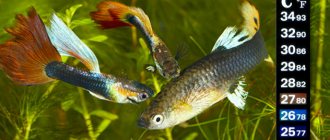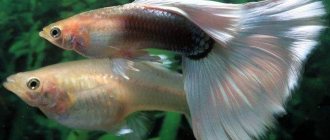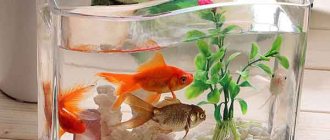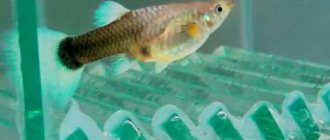Aquarium shrimp are no less popular than fish or aquatic plants. A transparent container with these arthropods will be a wonderful interior decoration, but before you get them, you need to figure out how much care they will require. This will largely depend on the species purchased, so it is better for beginners and experienced owners to purchase different representatives of arthropods.
There are different types of aquarium shrimp and difficulty in keeping them, so it’s better to study them better before purchasing.
general description
Although there are many types of aquarium shrimp, they all have one thing in common - the same body structure. They have a well-developed tail, eyes with a wide viewing angle, and long mustaches that perform the function of touch. Instead of claws, they have three pairs of jaws that perform a motor function. The entire body is covered with a layer of chitin. In addition, females are usually almost one and a half times larger than males.
In all other respects, these arthropods are not similar to each other. They differ in origin and belonging to a particular family, in size, color and habitat. Therefore, there are several types of aquarium shrimp. Some do not require special care, while others can only be kept by an experienced breeder.
How often should you feed shrimp in an aquarium with and without fish?
Shrimp inhabiting a separate aquarium must be fed much more often than in a community aquarium. And the frequency of feeding in this case is somewhat different. After all, in a general aquarium there are many additional sources of food.
Most often, feeding shrimp in this case is daily. But it can be done somewhat less frequently, once a day, depending on the specific type of shrimp. Sometimes, to determine the frequency of feeding shrimp, it is necessary to be guided by their characteristic behavior exhibited during starvation. Most species of shrimp become inactive when hungry. Well, a sure sign that it’s time for shrimp to feed is their increased consumption of useful ornamental vegetation in the aquarium.
How often to feed with fish
When the necessary and sufficient volume of additional food required for one-time saturation of the entire population of shrimp inhabiting a common aquarium is already known, you need to decide on the frequency of its supply.
Depending on the size and other characteristics of a particular type of aquarium shrimp, they can be fed daily or once every 2-3 days. The frequency of feeding shrimp can also be affected by the abundance or scarcity of natural food sources in a particular aquarium.
Some types of shrimp in good aquariums can survive without additional feeding for up to 7 days. Taking advantage of the numerous food sources in the general aquarium these days, shrimp most often do not notice the lack of additional food.
At what time should you feed shrimp in an aquarium with and without fish?
Shrimp kept both in a general and in a separate aquarium should be fed while they are active in search of food, at least 1-1.5 hours after the “dawn” that occurs for them after turning on the additional lighting of the aquarium. In the absence of daylight or auxiliary lighting, shrimp always sleep.
Feeding shrimp, despite possible 1-3-day pauses, is recommended to be done at the same time.
How and what to feed crustaceans in an aquarium, video:
Types for beginners
For those who are getting shrimp for the first time, it is better to pay attention to attractive, but unpretentious representatives who will not need to create special living conditions. These include the following varieties:
- Cherry - has a bright red body color, takes root well in the cramped conditions of a small aquarium.
- The bee shrimp has a blue color and a short body length of 2-2.5 cm, and reproduces quickly.
Cherry shrimp is ideal for a small aquarium - The yellow one of the corresponding color has a length of 2.5−3 cm.
- Green, unlike previous species, has a slightly larger size (3-3.5 cm) and reproduces more slowly.
- White pearls are grayish-white individuals 2-2.5 cm long. Females can be distinguished from males by the presence of ovaries, clearly visible in the transparent body.
- The blue pearl is the same size as the white pearl, but its color is more interesting. When you are in a good mood and feeling well, it is blue; if they deteriorate, the shade becomes very pale.
All these species are non-aggressive and do not cause trouble to their owner.
For experienced breeders
If you have successfully dealt with unpretentious creatures, you can try to get shrimp that require more careful attention. For example, one of these types:
- Red-nosed. The body of these 3-4 cm arthropods is translucent, and the nose is bright red. Breeding them is a little more difficult. Despite the successful adaptation of adults to life in fresh water, the larvae still need salty water. This species can not only be a decoration for the aquarium, but also bring practical benefits, for example, fighting unwanted algae.
The rednose shrimp has a transparent body and a long red nose. - Amano. Translucent gray-blue or light green shrimp measuring 4-5 cm. Feels good in the company of 10 relatives. The larvae also develop only in salt water.
- Harlequin. A very bright species, the color of which includes black, red and white. The representatives are very small - from 0.6 to 1.2 cm. They reproduce very slowly.
- The cardinal is also a very colorful variety, individuals have a body length of 2 cm. As for color, they are different shades of red with white dots along the body.
- Red crystal. The shrimp has a bright color and a size of 2.5-3 cm; it reproduces quickly.
Such decorative shrimp require professional care under the supervision of an experienced aquarist. To maintain them, special soil treatment and installation of a reverse osmosis system are required.
Basic conditions of detention
Shrimp in an aquarium require proper care. To ensure this, even before purchasing arthropods, you need to prepare their home and think about what they will need for a comfortable life in the future.
Choosing an aquarium
For shrimp, you need to choose a container of a suitable volume, where each representative will have about 0.5 liters of water. Of course, some species feel fine in more cramped conditions, but sufficient space will be the key to peaceful coexistence between neighbors.
You need to calculate the volume of the aquarium based on the number of shrimp. For each shrimp 0.5 liters of water
The shape of the container is not of paramount importance, but for beginners it will be more convenient to care for a rectangular wide tank that is easy to clean. You also need to remember to close the container with a lid to prevent its inhabitants from jumping out.
The optimal solution would be to start a shrimp tank, that is, a special aquarium where only arthropods will be settled. If fish live in the same container, hunting for small shrimp is inevitable, so they will need a large number of shelters, such as decorations, stones or moss.
Water preparation
Arthropods are more sensitive to water characteristics than fish. They usually do well in temperatures between 20 and 28 degrees Celsius. If the temperature rises to 32 degrees, they will die. If it drops to 15, they will stop reproducing and lose mobility, but there is no mortal threat. The previous behavior is quickly restored when the liquid is brought to normal temperature.
For unpretentious shrimp, you can use the most ordinary tap water. It’s even good if it has slightly increased rigidity, since the shrimp will build a shell from the elements included in it when molting. But too hard water will be uncomfortable and will stop reproduction.
Most shrimp do well in water 20-28C
More demanding creatures will need water with a nearly neutral pH and zero hardness. This is achieved by passing the liquid through a reverse osmosis unit. After this, you will need to add special salt to the water for a comfortable life for the shrimp.
Before pouring into the aquarium, the water must settle and reach room temperature. You can change the fluid only once a week, pouring out 1/5 of it and replacing it with fresh one.
Necessary equipment
As for aquarium equipment, the first thing you will need is a compressor, since a large number of shrimp may not have enough oxygen.
If there are a lot of shrimp, you definitely need a compressor for the aquarium.
Filtration systems are usually installed in aquariums where both arthropods and fish live, so the shrimper can do without it. But if there are a lot of inhabitants and few plants, then it is still better to purchase an external canister or internal sponge filter. To prevent small shrimp from being sucked in, you will need to place a sponge on the pipe of the device.
Crustaceans need lighting to form daily biological rhythms. In addition, aquarium plants cannot do without light. Fluorescent or LED sources are well suited for this purpose. They will work efficiently and economically, and the water will not heat up.
To maintain the desired temperature you will have to get a heater. It is better if it is equipped with a thermostat that maintains the set value. But you can’t always completely trust the device, so sometimes you need to control the temperature it sets using a thermometer.
If the days are hot and the water in the aquarium gets very hot, you will need to install a fan or refrigeration unit that reduces the temperature to acceptable values.
Waste must be removed regularly so that the ammonia released from it does not lead to diseases of the shrimp. To do this, you will have to carefully siphon the soil.
Suitable nutrition
Nutrition is an important point in keeping aquarium shrimp. They eat everything: algae buds, fish food, plant leaves. But they also need to be given boiled vegetables or special food purchased at a pet store. In the latter case, you need to pay attention to the composition. It must contain calcium, which is necessary for building the shell. Otherwise, the shrimp may begin to eat their own shell.
Frozen brine shrimp is suitable as food for shrimp.
Frozen food made from bloodworms, brine shrimp, or even cod meat is considered a good choice.
There is no need to feed arthropods more than 1-3 times a week, since they will already eat up the plants in the aquarium, and increased feeding can harm them. In addition, in nature they often go without food for 7-10 days.
Breeding rules
Reproduction occurs when the female reaches sexual maturity. At this time, she begins to secrete enzymes that attract the male. He fertilizes the eggs that appear under her tail, and after 4-6 weeks larvae emerge from them. As soon as they emerge from the eggs, they will immediately be able to feed on their own and, in general, lead a lifestyle characteristic of adults.
But for this process to occur, conditions for mating must be created. The female's achievement of sexual maturity can be accelerated by frequently replacing the water with fresh water. In this case, the shrimp molt faster, preceding the release of pheromones.
Shrimp fry immediately lead an independent lifestyle, like adults
After successful fertilization, you need to be even more careful about the characteristics of the water. Under any unfavorable factors, the female may shed her eggs and a new generation will not appear.
It is worth considering that up to 40 new larvae can appear at a time, but overpopulation usually does not occur, since with a lack of space and food, large individuals begin to feed on small ones, thereby regulating their numbers.
Choosing an aquarium
Experts advise choosing a rectangular or cubic aquarium, since it is easiest to arrange it in a natural habitat.
Shrimp can also be kept in small aquariums designed for 5 and 10 liters, but this can be done by experienced aquarists. Caring for nano aquariums is much more labor-intensive than large ones.
The most common option is to keep shrimp in tanks with a volume of 20-30 liters.
Shrimp 30l
Beginners are advised to opt for 50-liter containers, where it is easier to create the necessary conditions for demanding shrimp. The same minimum volume is needed for breeding crustaceans, since in small aquariums it is very difficult to select fry.
It is mandatory to have a lid and tightly seal all holes, as the shrimp can crawl.
Shrimp tank or community aquarium - what to choose?
Large shrimp (amano, filter feeders) can get along well with various fish, with the exception of large cichlids. But shrimp such as Macrabrachium rosenbergi, which grow up to 18 cm, can themselves become a danger to fish and smaller relatives.
When kept together, the tank is planted with moss and plants with small leaves so that young shrimp can hide from the fish. Many, even small fish, prey on young fish. There are no completely harmless fish.
Small ones, such as cherry shrimp, and very fastidious crustaceans are best placed in a species tank. Living with fish, they begin to hide and become nocturnal. In any case, it is necessary to clarify in advance the compatibility between the inhabitants.
Compatibility with fish
If you don’t want to have a separate shrimp tank, you can add arthropods to snails or small non-aggressive fish. Shrimp get along well with the following species:
- micro-assessments;
- guppy;
- platies;
- neons;
- Rhodostomus.
The neon fish can be a good aquarium neighbor for shrimp.
However, even these fish will be interested in too small neighbors and some of the shrimp will still be eaten. This can be avoided by introducing large enough arthropods to small fish so that they cannot swallow them.
It is worth remembering that there are species that will immediately eat new neighbors, regardless of their size. These include:
- barbs;
- fighting fish;
- cichlids;
- battles;
- angelfish.
No shelter can save shrimp from predatory and large fish.
Angelfish should not be placed near shrimp; the shrimp will be eaten
Checking into the aquarium
So, the container for shrimp is prepared, all the necessary equipment is installed, and the owner has decided on further care. But now the question arises of how to transfer new inhabitants to the aquarium without causing them stress due to a sudden change in conditions.
For check-in to be successful, you must adhere to the following rules:
- Acquire young representatives. Many people are reluctant to take young shrimp because they are dull in color, but this is wrong, as the color will develop as they mature. The older the arthropod, the more difficult it is for it to adapt to new conditions.
- Shrimp should be transported in a plastic bag or container with water and plant branches.
Shrimp should be moved to a new aquarium along with the water in which they were located. - It is necessary to move arthropods to a new container along with the liquid in which they were transported.
- Next, you need to gradually add water prepared in advance to the aquarium and watch the behavior of the shrimp. If everything is calm, you can add liquid to the required volume. If the arthropods begin to bend or rush around, you will have to change the parameters, for example, take more settled or warmer water.
Thus, by taking your time and monitoring the well-being of your new pets, you can successfully place them in a new place of residence.
Keeping in an aquarium
Keeping shrimp in an aquarium, although considered simple, still requires certain knowledge and experience. For example, you should not put them in a newly installed aquarium with fresh water, this can lead to death. The water should sit for at least a couple of weeks, microflora should develop in it, and only then can the shrimp be safely relocated to their new home.
Shrimp also cannot tolerate certain odors, in particular tobacco smoke. This means that you should not smoke in the room where they are kept, and you should not sprinkle food with your hands that were holding a cigarette.
You should not use chemicals in the aquarium, be it medicines for diseases or water stabilizers. Most of them contain copper sulfate and other copper impurities, and all freshwater aquarium shrimp are very sensitive to them.
Keeping fish is possible, but not all types. First of all, you need to exclude all types of predatory and large fish, these include:
- cichlids;
- barbs;
- labyrinthine;
- labeo;
- bots, etc.
For them, shrimp are just food, but not neighbors in the aquarium.
But with whom shrimp will definitely get along are small species of characins and viviparous fish. Great neighbors can be:
- micro-assessments;
- guppy;
- platy fish;
- neons;
- Rhodostomus and many other species.
As you can see, keeping fish together is possible, but don’t forget: fish taste everything that suits their mouth size. This means that small shrimp will serve as food for them, although, of course, they will not eat all the young ones.
For keeping cherry shrimp, the usual temperature parameters (20–24 degrees) are suitable; other water parameters are not so important. But various types of crystals and Sulawesi crystals are more demanding in terms of maintenance conditions:
- temperature 20-25 degrees;
- pH 6.5–7.2;
- GH – 4–6;
- KH 1–2.
A special soil for shrimp and a reverse osmosis system help create such conditions.
For beginner aquarists, it is recommended to keep cherry shrimp, Amano or Babaulti shrimp. They are unpretentious, have an attractive appearance and are undemanding to water parameters. Having gained experience, it is worth moving on to more demanding types.
Common mistakes
Those who decide to keep shrimp for the first time often encounter certain difficulties. Their pets get sick or even die, although it would seem that everything was done correctly: an aquarium was selected, water and food were prepared, all the necessary equipment was purchased.
Aquarium shrimp can get sick and die if the water in the aquarium is too stagnant
The thing is that small arthropods are very sensitive to various components of the environment. The owner should be aware that the following factors have a detrimental effect on them:
- Insufficiently settled water. Fresh liquid, in which microflora has not yet developed, is detrimental to shrimp, so before the first fill, the water should stand in a dark place for several weeks.
- Tobacco smoke. If you smoke in a room with an aquarium, aquatic inhabitants will not live long in such conditions. Shrimp are so sensitive to smell that they can be harmed even if you put food in them with an unwashed hand that was holding a cigarette.
- Medicines and water stabilizers. Any chemicals that contain the slightest traces of copper have a detrimental effect on arthropods.
Thus, the owner may accidentally make a mistake that will lead to the death of his pets. To prevent this from happening, you need to take responsibility for caring for the inhabitants of the aquarium, and then they will delight you with their beauty and health.
Optimal living conditions for shrimp
Shrimp are cold-blooded, so for their activity it is necessary to maintain the water temperature in the aquarium within 20-30 ° C. Their usual temperature is limited to 15 °C, beyond which the shrimp become passive and slow, and with a further decrease in temperature they may die. This is a conversation about neocardines and their other breeds. You should not overheat the water above 32 °C, this can also cause the death of shrimp.
Keeping shrimp does not require special water hardness standards, so you can use regular tap water. Hard water contains the necessary amount of minerals, which will be used to create the chitinous cover of shrimp. Tap water, in addition to hardness salts, contains a certain amount of phosphates, which are also not recommended to be removed, so the only requirement for water for a shrimp tank before settling it with inhabitants is the water temperature. But, there are a number of capricious shrimps that live only in osmotic water.
But such shrimp are practically not sold in stores. Temperature is an important indicator for their vital activity, since shrimp calmly tolerate a gradual decrease in temperature to 15 degrees, but experience temperature shock when it changes abruptly, for example, when transplanted from a shipping bag into an aquarium with heated water. You should wait until the temperature of the water in the bag and the aquarium returns to normal; to do this, place the bag or plastic container with shrimp in the aquarium.











